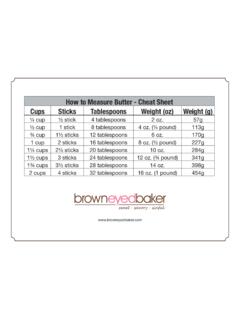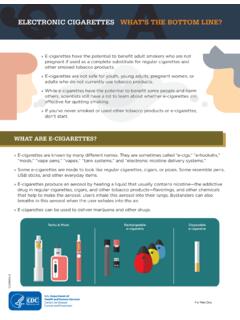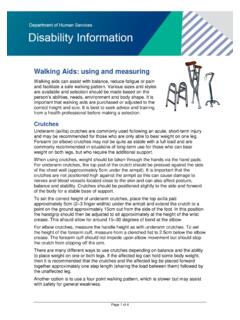Transcription of Key Stage 2 Quicksticks Hockey
1 Key Stage 2 Quicksticks Hockey Year 3 Invasion Games Lesson 1 Theme: Moving with the Ball / Possession Learning Objectives National Curriculum Programme of Study Children should learn to: Develop their dribbling skills with a stick and ball 1a, 1b, 3a, 4b, 5b, 7a Learning Outcomes Vocabulary Resources All children will understand how to dribble a ball keeping possession, keeping the ball A range of small and medium balls (including Most children will be able to dribble a ball dribble, travel (moving) with the ball the Quicksticks ball). Some children will be able to dribble a ball with control and confidence Hoops and cones, throw down markers Samba Sports' Hockey Goals Quicksticks or mini Hockey sticks bibs or bands for teams Adequate space Quicksticks Challenge Cards Warm Up Teacher Guidance Notes i.
2 Height order challenge everyone lines up along a marked line with the smallest at the left hand i. Children are put in height order to enable teacher to issue sticks to them according to their height. side and the tallest at the right hand side. As a guide the stick should come up to the child's hip bone. Note It is more about the child's comfort with the stick rather than a hard and fast rule of safety. ii. Hand out sticks relevant to the size of the pupils. In the Quicksticks kit bag there are three ii. Get children to use the handprint graphic to match left hand to grip. different size sticks: 30 (Blue) 32 (Yellow) 34 (Black).
3 Iii. Grip Hold the stick with the left hand on the foam grip. The hand should match the hand graphic iii. Hockey Hoovers will familiarise the children with the Hockey playing position and how to hold the on the grip. The pupil's right hand can go anywhere below the grip. stick. Ensure children bend knees slightly to avoid getting backache! iv. Hockey Hoovers' ask the children to run around with two hands on the stick and the stick head iv. Progression: shout out speed' or strength'. Children are to move their right hand to the relevant on the ground marked zones on the stick. v. Issue a ball to each child Challenge Delivery Programme Challenge Card 1: Space Dribble Every player needs a ball and a stick and should move the ball around the play area with their stick this is called dribbling.
4 The ball should always be in contact with their stick. Encourage players to try and find space (an empty area) as they dribble. They can go anywhere in the play area as long as they don't bump into each other! Challenge Card 2: Truck and Trailer This Challenge should be carried out in pairs and requires good teamwork. Each player needs a stick each and each pair needs a ball. Ask the players to choose who wants to be the truck and who wants to be the trailer to begin with. Trucks need to stand in front of the Trailers and should lead them around the play area making sure that they avoid other trucks and trailers! Trailers need to have the ball and need to follow the truck whilst dribbling the ball.
5 It is important that the truck doesn't lose the trailer by going too fast. The teacher should shout Pit Stop at which point the Trailer needs to stop the ball (under control). Swap roles and start again. Challenge Card 3: Team Island This challenge is a bit like musical chairs. Using chalk or cones, mark out some islands on the floor you could encourage children to do this themselves eventually. Every player needs a stick and a ball and as a group, they should pick someone to be in charge of the game (this could be the teacher to begin with). Every player starts with 5 points it's up to the players to keep their own score as they go along.
6 Players should dribble the ball around the play area until the person in charge shouts out a number. If the number is four, players have to dribble their ball to an island and make a team of four. If there are already four players on an island, they will need to dribble their ball to another island which has fewer than four people on it. Players who don't get on an island lose a point, while players who do get on an island gain a point. The first player(s) to get to the target number of points wins the game. For example, if the target number is 10, then the first player(s) to get 10 points is the winner. Challenge Card 4: Island Hopping This challenge is a bit like tag.
7 Using chalk or cones, mark out some islands on the floor you could encourage children to do this themselves eventually. One of the islands needs to be called Prison Island'. Players need to avoid being sent to Prison Island. Two players should be the catchers (if this is a big group, more players can be catchers). Non-catchers need a stick AND a ball, but catchers only need a stick because their aim is to steal the ball from the other players. Players need to dribble their ball from island to island (remembering to avoid Prison Island) without being caught by the catchers. Catchers are not allowed to go on any of the islands, so any players on an island are safe.
8 Players being chased by a catcher should dribble their ball to an island where they will be safe. Encourage children to keep moving from island to island trying to avoid being caught. They should be encouraged not to watch the ball as they move because they need to look around to make sure that the catchers are not nearby. To catch a player, the catcher has to steal the ball from a player, or needs to force them to lose control of the ball. Players who are caught need to go to Prison Island and count to 20 before they are allowed to play again. When they have counted to 20, they can start dribbling the ball again. Plenary What was our main objective in the lesson?
9 How do we dribble well? Develop dribbling skills with a stick and ball. Ball out in front so we can see ahead of us and so that the ball does not touch our feet. Which hand is at the top of the stick? How did we avoid getting caught in the last game? Left hand. Wait until catcher is chasing another player before leaving an island. Page 25.




